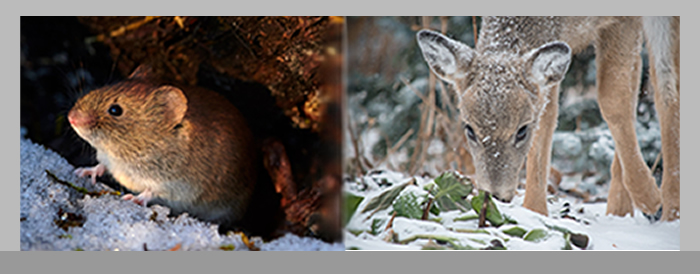Winter Plant Protection from Deer and Voles

Time to think about winter plant protection! Temperatures are dropping, and so are the leaves. Perennials and shrubs have halted their growth. Soon, snow will be falling. Meanwhile, deer, voles and other small animals that don’t hibernate are starving, putting your landscape plants at risk.
Decimation by Deer
A single adult whitetail deer requires 5 to 7 pounds of food per day. Since deer travel in herds, that number quickly climbs well into the double digits. In fall, they rely on acorns to survive, but many areas are reporting lower-than-usual numbers of acorns this year. Once it snows, even that is no longer an option.
That’s when they start decimating your yews, arborvitae, holly, rhododendron and anything else they can find to sustain them over the winter. Even normally deer-resistant plants are at peril when the need for food overtakes the deer’s preferences.
Voracious Voles
Despite the tiny size of voles, they can do a lot of damage – and the worst of it happens in the winter. They tunnel underground, safe from hungry predators. And what’s to eat underground? Plant roots and freshly planted bulbs! Voles also emerge to gnaw on tree bark, inviting disease.
What to Watch For
Watch for telltale signs to determine if you have a problem with deer or voles.
Deer cause damage relatively high off the ground, unlike other garden pests. They leave behind branches and stems with ragged, broken ends, as they don’t have upper incisors. They’ll girdle an unsightly “waist” around an arborvitae in short order. You may also detect their presence from their distinctive hoof prints and scat in your yard.
Voles do their damage very close to the surface. You may see gnawed bark and tooth scars that are crisscrossed and only about 1/16” across.
Proactive Protection
Thankfully, winter plant protection to fend off deer and voles takes just a few simple steps.
First, since voles prefer to burrow in protected areas, clear away debris and minimize the use of mulch in winter. The harder it is for them to hide, the more likely it is they’ll move elsewhere.
If you’re planting bulbs, you can protect them by pouring some Bobbex-R Rabbit & Small Animal Repellent into a small bowl and soaking the bulbs in it for 3 to 5 minutes. Allow them to air dry before planting. The Bobbex will create a powerful scent barrier that will deter voles and other critters from damaging the bulbs.
To protect trees and shrubs from deer damage, spray them with Bobbex Deer Repellent when the temperature is above 35 degrees. Repeat the application every two months to ensure continued protection. If you use a landscaper, ask them to apply Commercial Bobbex Dormant Season Formula for extended winter protection.
With these few simple steps, you’ll have your winter plant protection in place quickly, and your neighborhood deer and voles will be looking elsewhere for their next meal.
